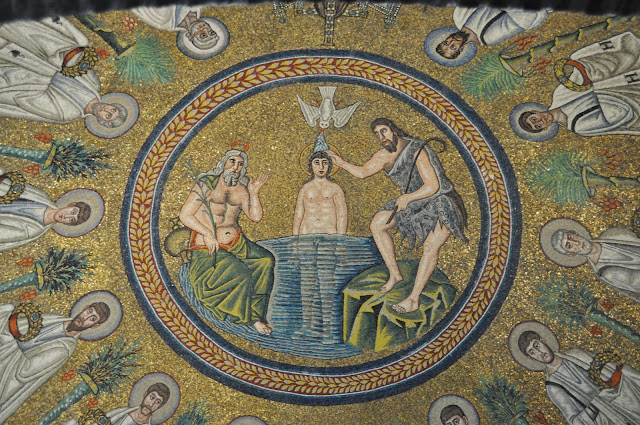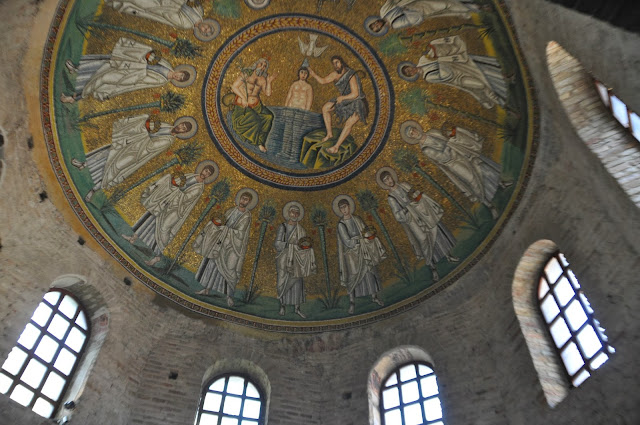First encounter with the byzantine mosaics was in the Arian Baptistry. The splendid mosaic in the dome showed the baptism of Christ. I find it interesting to learn that in the Arian concept, the Son of God did not always exist but was created by God the Father. This was obviously considered heresy by the Catholic Church and most of the other Christian denominations. Arianism did not survive beyond the 8th century. This Arian Baptistry was built early in the 6th century.
 |
| Baptism of Christ mosaic in the dome |
Like everyone else, I was awe-struck when I walked in the unassuming side door and saw the magnificent interior
The eight pillars that support the dome were encased in gorgeous marble
The vault paintings were done in the 18th century but it was the mosaics in the apse and choir that are the most impressive. Interestingly enough, the upper gallery was called the matroneum - meant for married women.
Beautifully decorated stucco beneath the arches
The stunning semi-dome in the apse depicting a beardless Christ
 |
| The lunettes (half-moon) all around were decorated with scenes from the Old Testament |
 |
| The extremely fine work in the vault depicting the Paschal Lamb and angels |
 |
The floor mosaics are no less impressive |
 |
We could have spent hours in the Basilica admiring the mosaics and the marble - but we had to move on... |
We literally stumbled into the Museo Arcivescovile (Archiepiscopal Museum) not realizing what was in it. It was included on our Basilica ticket but we were short on time so was on the verge of bypassing it. But when I saw stairs like these, I figured there would be some good stuff inside - and I was right!

What you see below is the mosaic inside the little chapel that is in the museum among other exquisite finds on several floors. 

Even more astonishing was the carved ivory throne chair - the Throne of Maximian, from the 6th century, made for the Archbishop of Ravenna (possibly in Constantinople), and apparently a gift from the Emperor Justinian. What a find!
Just next door to the Museum is the most ancient monument remaining in Ravenna - the octagonal Orthodox Baptistry (as distinguished from the Arian one above), built in the 4th century, converted from a Roman bath.
 |
| Another baptism of Christ mosaic - it's interesting to compare it to the one in the Arian Baptistry, built 50 years later. |
 |
The most interesting item for me was the unusual Greek marble pulpit from the 6th century - it was surmised that this may have been reconstructed from the lids of two sarcophaguses. |
From the cathedral, we headed across town to the Basilica of St. Apollinare Nuovo with the intention of dropping by the tomb of Dante on the way. We missed it somehow when we got disoriented coming out of the cathedral and ended up having to double back after visiting the Basilica. The St. Apollinare Nuovo Basilica, originally built by the Arians in the early 6th century, was reconsecrated as a Catholic church later.
 |
| I love the bell tower with its mullioned windows built at the beginning of the 11th century. |
Mosaics down both sides of the church - on one side the procession of 22 virgin martyrs preceded by the three magis offering gifts to baby Jesus seated on the Virgin Mary's lap; on the opposite side, 2 martyrs approaching Christ enthroned - quite a magnificent display!
 |
| Basilica of St. John the Evangelist |
 |
| Remnants of ancient mosaics |
Next post: Ravenna, the town



















No comments:
Post a Comment